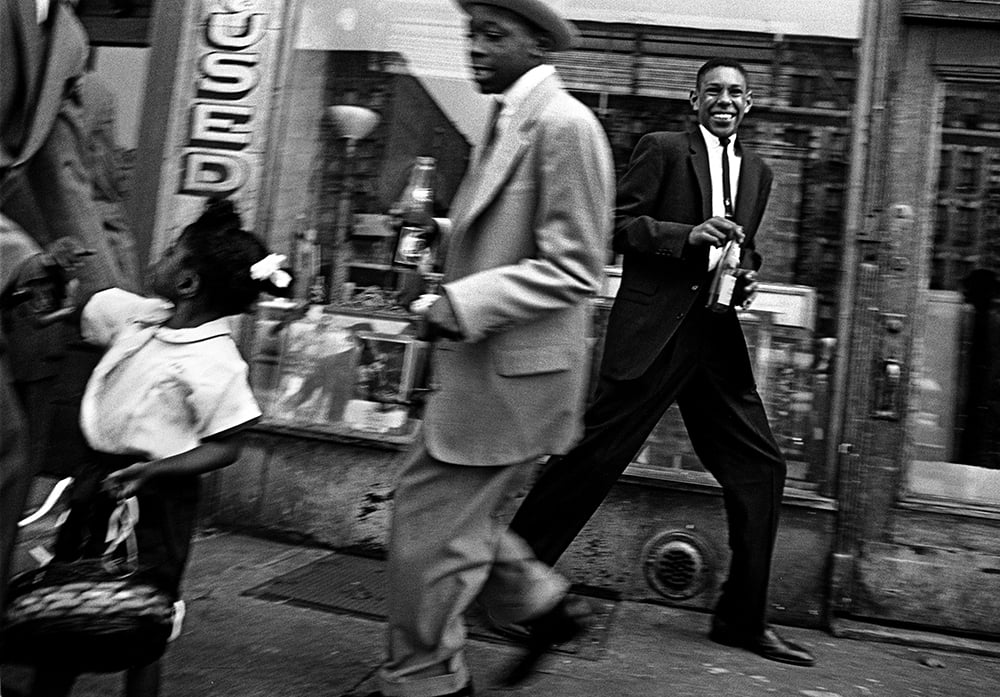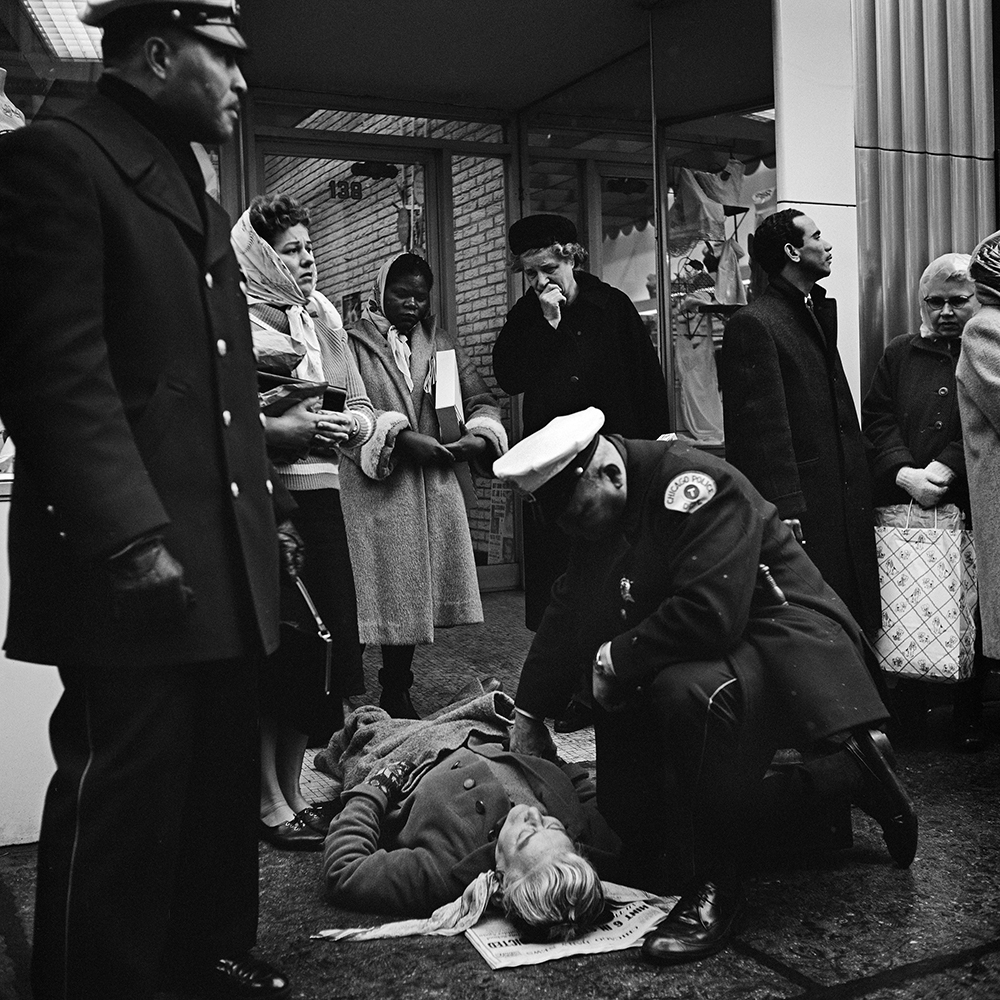
February 26, 2014
Ballet of the Sidewalk: Why Walkable Cities Are Better for the Soul
Author Jeff Speck asks how lively streets can make for not just walkable cities, but good and just ones.

Moves + Pepsi, New York City, 1955 © William Klein
The soul of a city can be found by taking a walk. This is the essential premise behind all great street photography. Here we present both classic examples and contemporary work, from Vivian Maier and William Klein to Boogie.
Now that my book Walkable City (Farrar, Straus and Giroux, 2012) has been out for more than a year—and has found a larger audience than I had expected—it seemed a good time to reflect on the book’s message, and consider what I might have overlooked. One thing I missed was pictures. On the advice of Witold Rybczynski, I left them out, and I’m glad. Real writing doesn’t need it, he said, and—more importantly—picture books get shelved in the back under “Architecture” rather than in front under “Current Affairs.” Also, however many words a picture may be worth, there is perhaps a greater value in letting people imagine their own pictures from your words. The better-paid public speakers have better PowerPoints, but the best paid have none.
But some folks still want pictures, clear illustrations of how it can be done, and my next book will most likely have them, because it—the walkable city—can be done, is being done, and should be done, everywhere. In the meantime, I hope that these images of timeless urbanity by the likes of Vivian Maier and William Klein provide a suitable backdrop to what follows, the main theme missing from my book: walkable cities are better for your soul.
My confidence has been steeled for this task by another book, just out, Charles Montgomery’s Happy City: Transforming Our Lives Through Urban Design (Farrar, Straus and Giroux, 2013), and also by a recent visit to my personal version of hell, also known as the sprawl. In this case, the sprawl was West Jordan, Utah, home to my in-laws, whom I adore, and about the least happy place I can imagine.
The natural landscape could hardly be more spiritual; the Mormons stopped at Salt Lake for a reason. With the Wasatch Range to the east and the Oquirrh to the west, breathtaking views abound. On clear days—increasingly rare, thanks to car exhaust—it feels godly. Until one lowers one’s gaze to the earth, which has been colonized—planned, by planners—to be the most soul-crushing place on the planet.
West Jordan, population 108,000, sits 18 miles south of Salt Lake City, where it was once its own town. It has since been subsumed by the creeping sprawl of the Salt Lake City metro, in which more than one million people have spread like a rarefied gas across more than six million acres. From the sky, hardly a person can be seen, as the vast majority of time in the public realm is spent in automobiles, traveling between stoplights a half-mile apart at speeds approaching 50 miles per hour. The standard nonresidential street is 80 feet from curb to curb and flanked by nothing but chain stores behind parking lots. One intersection famously sports two massive 7-Eleven gas stations, right across the road from each other.

December 21, 1961. Chicago, IL. © Vivian Maier/Maloof Collection
The homes, while nondescript, are lovely. Step inside from the garage—front doors are rarely used—and you’re met with vast expanses of space in which every amenity can be found. All the pleasures that were once provided publicly by the community are now provided privately by the middle-class house. The theater has been replaced by the giant-screen TV, the pool hall has made its way into the rec room, and the playground has become the backyard jungle gym.
This is wrong. The privatization of the public realm means the end of community life, and we don’t need a new, better pope to tell us what that does to our spirit. Actually, all we need is Harvard University professor Robert Putnam, who, in Bowling Alone: The Collapse and Revival of American Community (Simon & Schuster, 2000) mapped a clear connection between suburbanization and a decline in civic engagement. As we drive more, we spend less time publicly, which allows the public realm to deteriorate further, causing us to drive more.
And is there a less noble version of a human than the motorist? Whether due to the sheer sense of power that the automobile confers, or the fact that our lives are literally at risk for much of the time on the road, driving has a profoundly uncivilizing effect. You don’t need me to prove this to you; how many times have you given someone the finger as a pedestrian?

Mukattes, Roma bride dancing at her wedding, Istanbul. 2011 © Courtesy Rena Effendi/Institute
In addition to making me less civil, motoring around the tawdry dreckscape of commercial West Jordan just plain-old gave me the blues, bringing to mind my favorite recent read: Happy City. In this book, Montgomery writes convincingly about what sort of built environment makes us better love our lives and better love our neighbors—which, it turns out, is pretty much the same thing. This is a subject that I have only skimmed the surface of in my own work, because I like to use data, and how do you quantify happiness? As Montgomery notes: “To test the idea you would have to decide what you meant by happiness, and you would need a way to measure it…you would have to tabulate the psychological effects of driving in traffic, or catching the eye of a stranger on the sidewalk….”
It turns out that there are ways to quantify happiness, and there is even a science of happiness—which may or may not be pseudo, but is at least based upon sound principles. It begins necessarily with the premise that the best way to determine people’s happiness is to ask them. This approach is arguable, but seems a better strategy than any of the alternatives. So we poll populations, and cross-reference the data with urban conditions.
To my disappointment, but not to my complete surprise, the happy city isn’t exactly the walkable city. Or, more accurately, the happy city is eminently walkable, bikeable, and transit-served, but it is decidedly not some of the cities that I lavish praise upon in my book, such as New York and Hong Kong. These cities are too dense, too lacking in natural beauty, and too encumbered by class distinctions to be optimally happifying. Each of these following qualities deserves more attention, at least from me.

Gypsy Kids in Downtown Belgrade, Belgrade 1998. ©Boogie
Elbow Room
While there are exceptions, the densest cities are generally the most sustainable cities, principally because people drive less. But they’re not the happiest cities, because people like their space. The glories of urban propinquity must be met with opportunities for decompression, or the happiness meter begins to dip. Fortunately, good planning can give us moderate-density places that are eminently sustainable, by organizing walkable villages around train stations that connect easily to downtown. For too long, antisuburban snobbery has lumped together such leafy havens as Forest Hills Gardens in Queens, New York, with the rest of suburbia, when they feel and function nothing like postwar auto-dependent sprawl. The transit-served garden suburb is an important part of the happy city.
Green Space
Nature deficit disorder is real, and must be countered with more than the occasional New Urbanist “pocket park.” The mandate for contin-uous corridors of natural (or naturalistic) open space within our cities can’t be forgotten as we work to make every pedestrian’s walk useful, safe, comfortable, and interesting—the hierarchy of requirements that underlie Walkable City. The popularity of the High Line derives, in part, from its linear interweaving of the natural with the man-made, and sends us on a search for similar opportunities in our cities. The obvious next step for New York is the greening of the entirety of Broadway from 17th to 108th Streets, where it is utterly redundant to the Manhattan grid, and not needed for vehicular traffic.
Economic Justice
The other item that moves Montgomery’s Happy City beyond my Walkable City is its trenchant discussion of relative social status and its role in determining perceptions of well-being. Simply put, a city cannot be happy when a large segment of its population is much poorer than the others. Low social status, Montgomery writes, “is like standing in a shower of stress hormones every day.” Moving further up the “hedonic treadmill” in such societies doesn’t make things much better: “the richer you get, the more you compare yourself to other rich people and the faster the wheel of desire spins beneath your feet….” With happiness as our measure, almost nobody’s a winner in the stratified city. This is unfortunate as, within our walkable cities, such stratification is becoming greater every day.
And here is where my argument is perhaps most in need of an update. For several decades, we New Urbanists have been stressing the distinction between standard of living and quality of life. Montgomery echoes that point, reminding us that the standard-of-living model suggests that “well-being is actually inflated by divorces, car crashes, and wars, as long as those calamities produce new spending on goods and services….” But he takes it a step further, noting that residents of “big, high-status cities (such as Toronto and Vancouver, which consistently hover near the top of global quality-of-life lists) say they are much less satisfied with life than people living in small towns….” The evidence would suggest that a high quality of life does not translate into feelings of well-being in places where social stratification creates a culture of status anxiety.
Until now, quality of life was my ultimate measure. Now things don’t seem so simple. Somewhere, at the intersection of the quality-of-life city, the sustainable city, the equitable city, and the happy city, lies the good city. I don’t doubt that it is also the walkable city, but walkability alone does not get us there.





